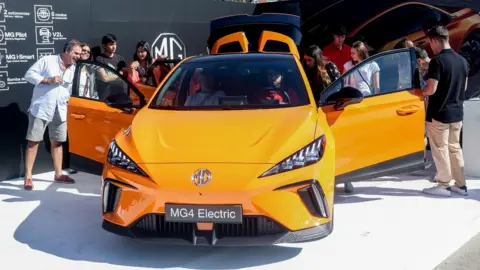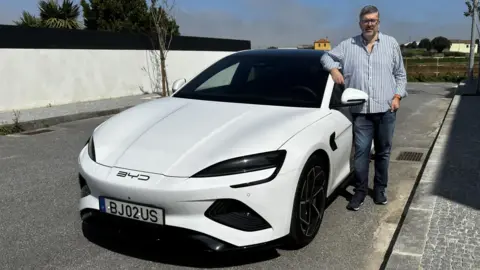from João da Silva, Business reporter
 Getty Images
Getty ImagesThe European Union has raised tariffs on Chinese electric vehicles as Brussels moves to protect the bloc’s motor industry.
The new tariffs on individual products range from 17.4% to 37.6%, which is on top of a 10% tariff that was already in place on all electric cars imported from China.
This could increase the price of EVs across the EU, making them less affordable for European consumers.
The move is also a major blow to Beijing, which is already in a trade war with Washington. The EU is the largest overseas market for China’s electric vehicle industry, and the country is banking on high-tech products to help revive its flagship economy.
EU officials say this surge in imports was fueled by “unfair subsidisation”, which allowed electric vehicles made in China to be sold at much lower prices than those made in the bloc.
China has denied this accusation, repeated by the US and the EU: Beijing is subsidizing excess production to flood Western markets with cheap imports.
The new charges take effect on Friday but are currently temporary while the investigation into Chinese state support for the country’s electric vehicle makers continues.
So who are the potential winners and losers in this trade dispute?
It is not only Chinese brands that are affected by this move. Western firms that make cars in China are also under scrutiny from Brussels.
By imposing tariffs, Brussels says it is trying to correct what it sees as a distorted market. The EU’s decision may seem tame compared to a recent move by the US to raise its total tariffs to 100%, but it could be far more significant. Chinese electric cars are a relatively rare sight on US roads, but much more common in the EU.
The number of electric vehicles sold by Chinese brands across the EU rose from just 0.4% of the total EV market in 2019 to almost 8% last year, according to figures from Brussels-based green influence group Transport and Environment (T&E).
Patryk Krupcala, an architect from Poland who expects to take delivery of a brand new Chinese-made MG4 in two weeks, told the BBC: “I chose an MG4 because it’s quite cheap. It’s a really fast car and it’s rear-wheel drive like my previous car which was a BMW E46.”
T&E designs firms such as BYD and Shanghai Automotive Industry Corporation (SAIC), the Chinese owner of the former British marque MG, could reach a market share of 20% by 2027.
But not all Chinese-made electric vehicles will be hit equally by the new tariffs.
Winners and losers
They were calculated based on estimates of how much state aid each firm received, while companies that cooperated with the investigation saw the liabilities that were hit. Based on these criteria, the European Commission has set individual duties for three Chinese electric vehicle brands – SAIC, BYD and Geely.
SAIC has been hit with the new higher rate of 37.6%. State-owned SAIC is the Chinese partner of Volkswagen and General Motors. It also owns MG, which makes one of Europe’s best-selling EVs, the MG4.
“The non-cooperation award is a severe blow to SAIC, which derives 15.4% of its global revenue from electric vehicle sales in Europe,” said Rhodium Group, an independent research firm.
For Mr Krupcala, who bought his MG4 before the tariffs came, the EU measure doesn’t really matter: “I don’t really care about the tariffs. I have a nice car with a seven-year warranty.”
It’s a different story for China’s biggest EV maker, BYD, as it faces a 17.4% surcharge on vehicles it ships from China to the EU.
This is the lowest increase and one that according to research by Dutch bank ING will “give the carmaker an advantage in the European market”.
Luís Filipe Costa, an insurance industry executive from Portugal who just bought a BYD Seal, says price was one of the deciding factors when he chose his new car.
But he added that even if the European Commission’s new tariffs had already been imposed, he would still have gone with BYD because “other brands would be affected too”.

Geely, which owns Sweden’s Volvo, will have a 19.9% surcharge.
According to Spanish bank BBVA, the company “will still export to the EU profitably”, but “its profits will be significantly reduced”.
Other firms, including European carmakers that operate factories in China or through joint ventures, will also have to pay more to bring electric cars into the EU.
Those believed to have cooperated with the investigation will face an additional charge of 20.8%while those EU investigators see as uncooperative will pay the highest fee of 37.6%.
US-based Tesla, which is the largest exporter of electric vehicles from China to Europe, has requested an individually calculated tariff, which EU officials have said will be determined at the end of the investigation.
However, the firm has posted a notice on some of its European websites that prices for its Shanghai-made Model 3 could rise due to the new tariffs.
Last year, businessman Lars Koopmann, who lives in the motor industry powerhouse that is Germany, bought a Tesla Model Y made in China.
Koopmann says he particularly liked the car’s high-tech features, such as the large touchscreen.
“The price was also a big factor that set it apart from the premium German brands,” says Mr Koopmann.
“If tariffs had been imposed, they would always have influenced my decision.”
Localization of production
While some China-based exporters will be better off than others, it is clear from the European Commission’s plans that they will all face higher costs when shipping to Europe.
Hardest hit “will be SAIC brands such as MG… as well as joint ventures between foreign and Chinese firms in China, which often have tighter profit margins on cars they export to Europe,” Rhodium says.
“The biggest beneficiaries of the duties are European-based manufacturers with limited exposure to China, such as Renault.”
In other words, the duties are likely to do as the EU hopes — reduce the number of Chinese-made EVs coming to the region, easing pressure on domestic manufacturers.
There is also another result of the move – some large Chinese electric vehicle firms are planning to build manufacturing capacity in the EU, which could help shield them from the new duties.
Work on BYD’s first European factory is underway in Hungary, and production is expected to begin there by the end of next year.
Chinese carmaker Chery has recently signed a joint venture agreement with a Spanish firm that will see the two companies produce EVs and other types of cars in Barcelona.
And, SAIC is looking to secure a site for its first plant in Europe.
“It’s a well-architected plan to encourage companies to shift their investment to the EU, rather than relying on exports from China,” said Bill Russo, of Shanghai-based consultancy group Automobility.
“The fact that some companies are taxed more than others is a signal that they will make the penalty higher or lower based on the degree to which the company is committed to investing in the EU.”
The Chinese government placed its bet on EVs early on.
According to the Center for Strategic and International Studies, between 2009 and 2023 more than $230bn (£181bn) of state support was poured into the industry.
As a result, its EV industry has become a world leader.
The International Energy Agency says China accounted for more than 60% of the world’s new electric car sales last year.
While the vast majority of electric vehicles produced in China are sold domestically, overseas markets, and particularly in Europe, have become increasingly important.
“Exports are the profitable segment,” said Rhodium senior analyst Gregor Sebastian.
“EU tariffs will hurt China’s EV industry because these exports help recoup losses from China’s domestic price war.”
Meanwhile, the world’s second-largest economy is struggling to shake off an economic slowdown in the wake of the pandemic and an ongoing property crisis.
Faced with lower levels of domestic consumption and investment, China is trying to “export its way out” of the downturn, says Alicia Garcia-Herrero, chief economist for the Asia Pacific region at investment bank Natixis.
And Beijing is making another big bet on EVs by making the industry one of its “Three New” growth drivers — a government plan to revive the economy that also relies on exports of batteries and renewable energy.
However, with major markets such as the US, EU and others imposing tariffs and other barriers, it looks like China’s latest gamble could deepen trade tensions with some of its biggest trading partners.


